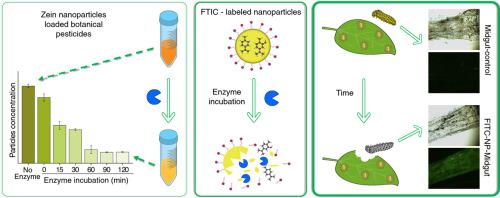Journal of Hazardous Materials ( IF 12.2 ) Pub Date : 2021-05-07 , DOI: 10.1016/j.jhazmat.2021.126004 Renata Aparecida Monteiro 1 , Marcela Candido Camara 1 , Jhones Luiz de Oliveira 2 , Estefânia Vangelie Ramos Campos 3 , Lucas Bragança Carvalho 1 , Patrícia Luiza de Freitas Proença 1 , Mariana Guilger-Casagrande 4 , Renata Lima 4 , Joacir do Nascimento 2 , Kelly Cristina Gonçalves 2 , Ricardo Antônio Polanczyk 2 , Leonardo Fernandes Fraceto 4

|
Nanoencapsulation of biopesticides is an important strategy to increase the efficiency of these compounds, reducing losses and adverse effects on non-target organisms. This study describes the preparation and characterisation of zein nanoparticles containing the botanical compounds limonene and carvacrol, responsive to proteolytic enzymes present in the insects guts. The spherical nanoparticles, prepared by the anti-solvent precipitation method, presented in the nanoparticle tracking analysis (NTA) a concentration of 4.7 × 1012 ± 1.3 × 1011 particles.mL−1 and an average size of 125 ± 2 nm. The formulations showed stability over time, in addition to not being phytotoxic to Phaseolus vulgaris plants. In vivo tests demonstrated that formulations of zein nanoparticles containing botanical compounds showed higher mortality to Spodoptera frugiperda larvae. In addition, the FTIC probe (fluorescein isothiocyanate) showed wide distribution in the larvae midgut, as well as being identified in the feces. The trypsin enzyme, as well as the enzymatic extract from insects midgut, was effective in the degradation of nanoparticles containing the mixture of botanical compounds, significantly reducing the concentration of nanoparticles and the changes in size distribution. The zein degradation was confirmed by the disappearance of the protein band in the electrophoresis gel, by the formation of the lower molecular weight fragments and also by the greater release of FTIC after enzymes incubation. In this context, the synthesis of responsive nanoparticles has great potential for application in pest management, increasing the selectivity and specificity of the system and contributing to a more sustainable agriculture.
中文翻译:

玉米醇溶蛋白基纳米颗粒在有害生物控制中负载了植物农药:针对可持续农业的酶促响应方法
生物农药的纳米包封是提高这些化合物的效率,减少损失和对非目标生物的不利影响的重要策略。这项研究描述了含有植物化合物柠檬烯和香芹酚的玉米醇溶蛋白纳米粒的制备和表征,该纳米粒对昆虫肠道中存在的蛋白水解酶有反应。通过抗溶剂沉淀法制备的球形纳米颗粒在纳米颗粒跟踪分析(NTA)中的浓度为4.7×10 12 ±1.3×10 11颗粒mL -1,平均大小为125±2 nm。除了对菜豆没有植物毒性之外,该制剂还显示出随时间的稳定性。体内试验表明,含有植物性化合物的玉米醇溶蛋白纳米颗粒制剂对草地夜蛾具有较高的死亡率。幼虫。此外,FTIC探针(异硫氰酸荧光素)在幼虫中肠中分布广泛,并在粪便中被发现。胰蛋白酶以及昆虫中肠的酶提取物可有效降解包含植物化合物混合物的纳米颗粒,从而显着降低纳米颗粒的浓度和尺寸分布的变化。玉米醇溶蛋白降解是通过电泳凝胶中蛋白质条带的消失,分子量较低的片段的形成以及酶温育后FTIC的更大释放来证实的。在这种情况下,反应性纳米粒子的合成具有巨大的潜力,可用于有害生物管理,











































 京公网安备 11010802027423号
京公网安备 11010802027423号